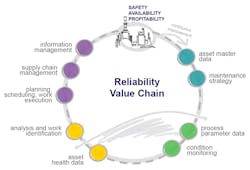When Emerson bought Management Resources Group (MRG) last year, the reliability consulting services firm’s founder and CEO Bob DiStefano told Steve Sonnenberg that Emerson was not a reliability company. But Sonnenberg, president of Emerson Process Management, insists that today, Emerson is most definitely in the reliability business.
That’s not only because of its acquisition of MRG, which group vice president Jim Nyquist refers to as “reliability doctors,” but also because Emerson, like its customers, recognizes reliability as an important business strategy that must be a board-level initiative, to be embraced and supported.
When speaking to industry press at an event associated with this year’s Emerson Exchange in Orlando, Fla., Nyquist stressed reliability’s relation to safety, availability and profitability.
Transient situations like shutdowns and startups create additional risk for process facilities, which means that any unplanned downtime caused by reliability issues is going to have a significant impact on safety. Unplanned downtime also relates to availability, of course, with as much as 5 percent of production capacity lost each year to unplanned shutdowns, Nyquist said.
“This is a problem we can solve. This should not be an issue in our industry, and yet it is,” Nyquist said. “The more we can address this issue…the more we can start working on the 5 percent availability issue.”
The availability to make product hits straight at the profitability issue, but profitability is also affected in terms of maintenance costs. On average, it costs 50 percent more to repair a failed asset than if the problem had been addressed before failure, according to the U.S. National Response Center.
Considering all the bottom-line benefits, Emerson isn’t the only company paying more attention to reliability these days. “In the last several years, there’s been a palpable difference in the awareness in the boardroom about the linkage between maintenance and the bottom line,” said DiStefano, now vice president and general manager of reliability consulting for Process Systems and Solutions at Emerson.
Executives are paying more attention to asset management, he said. They’re dissatisfied that they’re getting more and more data without an enhanced ability to make decisions, and they’re realizing that there is value in planning a new asset with reliability in mind.
“There’s a lot of money at stake,” DiStefano urged, noting that manufacturers can achieve better operating performance simultaneously with lower maintenance costs. “For every $100 spent on maintenance at top performers, poor performance spends 3.5 times that.”
So while those plants in the top quartile of performance are spending 1.4 percent of their plant replacement value on maintenance, poor performers are spending 3.5 times that. And while top performers achieve 96.7 percent mechanical availability, poor performers come in at 14 percent below that, DiStefano said.
MRG—and now Emerson—is in the business of helping customers get to that top quartile in reliability performance. Three customers spoke during the press conference about the efforts MRG helped them make and the results they achieved.
Revealing the Superman shirt under his suit, Kevin Shoemaker, senior vice president of operations at bio-based ingredients company Corbion, talked about the big changes that are needed to get real reliability results. “If we focus on small changes in what we do, we cause slight changes in what we get,” he said. “We have to have significant changes in how we see the world.”
Shoemaker also spoke of the paradigm shift from time-based to condition-based maintenance. “We want to do maintenance back on the curve when we have time to react, time to plan, time to perform,” he said.
And Corbion has gotten the results. Plant operational equipment effectiveness (OEE) rose from about 88 percent in 2007 to 97 percent in 2012. And maintenance costs this year are only three-quarters what they were in 2005.
Since 2012, Shoemaker and his team have been working to get from their 2 percent spend on plant maintenance to the 1.4 percent of top-quartile performers. With an integrated approach of a computerized maintenance management system, advanced analytics, condition-based monitoring, reliability strategy, and live asset health and KPIs, they’re now at 1.75 percent, Shoemaker said.
Representatives from PolyOne and Lucite Singapore had similar stories to tell. “In operations, when we looked at the reliability area, we found a lot of hardworking and dedicated people, but also found difficulty turning that hard work into results,” said Kevin Bodine, manufacturing director at PolyOne, a global provider of specialty polymers.
Bodine emphasized the importance of an ongoing program. “Any time that you have a rollout program like this, you can’t just walk away and expect it to keep going,” he said, noting that each plant continues to analyze failures in order to remove the causes. “All of this is with an emphasis on cultural and collaborative change between production and maintenance.”
About the Author
Aaron Hand
Editor-in-Chief, ProFood World

Leaders relevant to this article:
